Healthy Settings: Theory, Policy, and Practice in Public Health
VerifiedAdded on 2022/08/12
|21
|6672
|15
Report
AI Summary
This report delves into the multifaceted concept of healthy and sustainable settings, exploring its theoretical underpinnings, policy implications, and practical applications within the context of public health. It examines the significance of social determinants of health in the United Kingdom, highlighting issues such as obesity, heart disease, and mental health disorders. The report emphasizes the shift from deficit-based to asset-based approaches, illustrating the 'assets based approach' through the example of healthy university settings, which utilize stakeholder asset mapping, needs assessment, and action plans. It explores various theories like the socio-ecological approach, organizational development, salutogenesis, and whole system change, and how these models translate theory into practice. The report also addresses the importance of community engagement, organisational change, and sustainable development, referencing the 'Settings' based health promotion model. The report concludes by highlighting the critical role of health promotion in fostering community-based services and improving the overall quality of life, emphasizing the promotion of sustainability, corporate social responsibility, and resilience in community settings. It highlights the importance of a culturally competent approach to health care delivery and the role of healthy universities and other settings as examples of whole-system health-promoting environments.
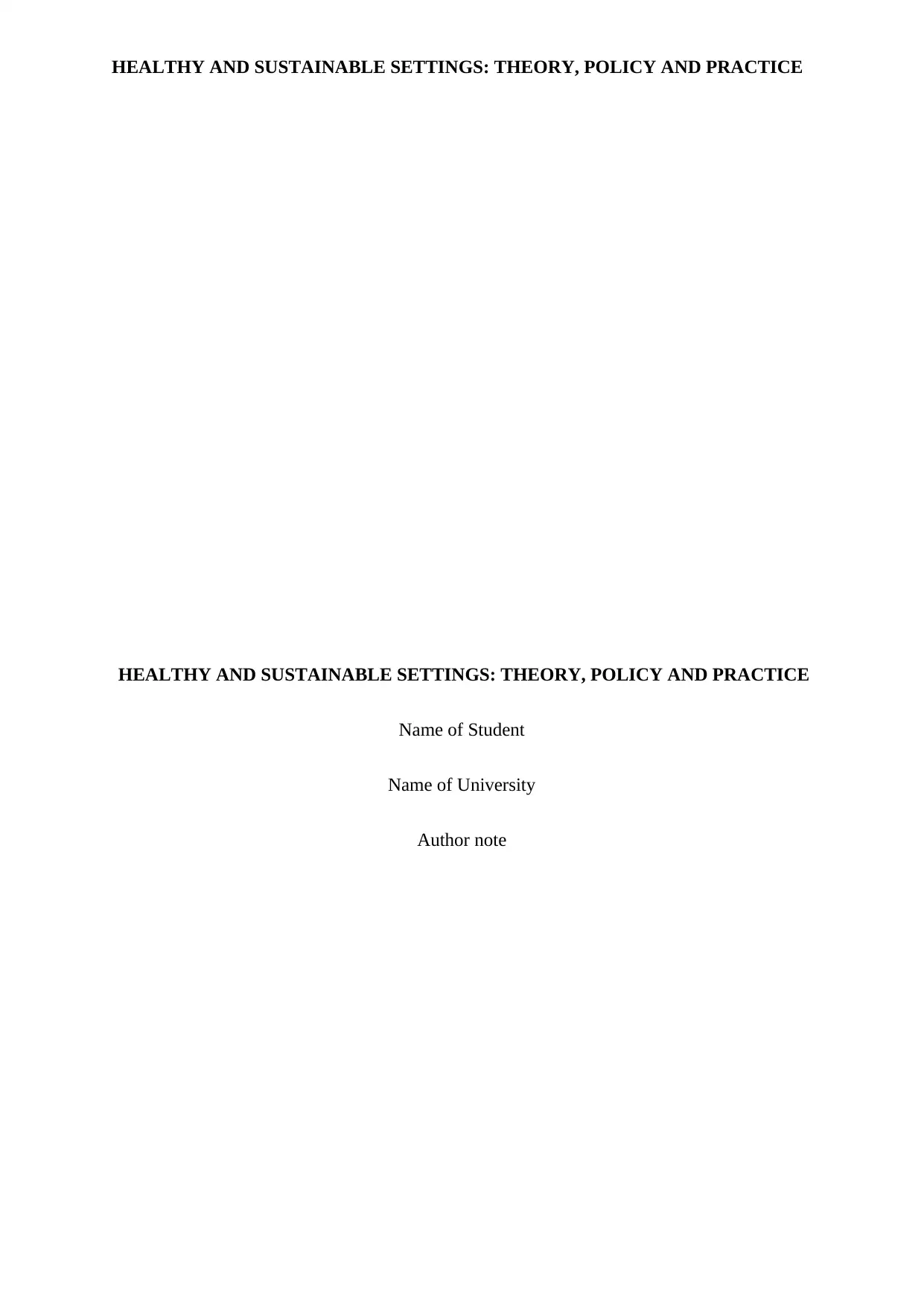
HEALTHY AND SUSTAINABLE SETTINGS: THEORY, POLICY AND PRACTICE
HEALTHY AND SUSTAINABLE SETTINGS: THEORY, POLICY AND PRACTICE
Name of Student
Name of University
Author note
HEALTHY AND SUSTAINABLE SETTINGS: THEORY, POLICY AND PRACTICE
Name of Student
Name of University
Author note
Paraphrase This Document
Need a fresh take? Get an instant paraphrase of this document with our AI Paraphraser
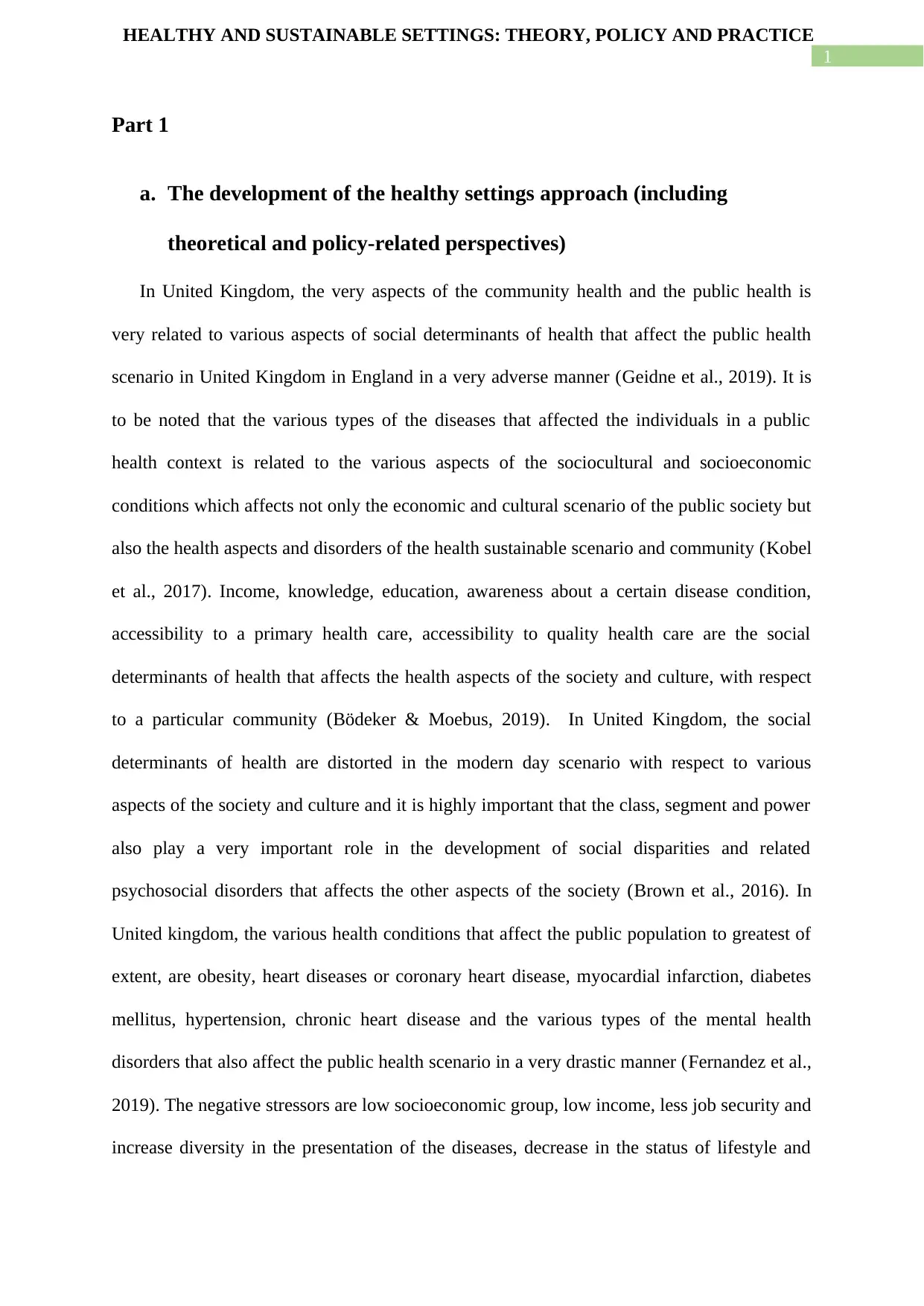
1
HEALTHY AND SUSTAINABLE SETTINGS: THEORY, POLICY AND PRACTICE
Part 1
a. The development of the healthy settings approach (including
theoretical and policy-related perspectives)
In United Kingdom, the very aspects of the community health and the public health is
very related to various aspects of social determinants of health that affect the public health
scenario in United Kingdom in England in a very adverse manner (Geidne et al., 2019). It is
to be noted that the various types of the diseases that affected the individuals in a public
health context is related to the various aspects of the sociocultural and socioeconomic
conditions which affects not only the economic and cultural scenario of the public society but
also the health aspects and disorders of the health sustainable scenario and community (Kobel
et al., 2017). Income, knowledge, education, awareness about a certain disease condition,
accessibility to a primary health care, accessibility to quality health care are the social
determinants of health that affects the health aspects of the society and culture, with respect
to a particular community (Bödeker & Moebus, 2019). In United Kingdom, the social
determinants of health are distorted in the modern day scenario with respect to various
aspects of the society and culture and it is highly important that the class, segment and power
also play a very important role in the development of social disparities and related
psychosocial disorders that affects the other aspects of the society (Brown et al., 2016). In
United kingdom, the various health conditions that affect the public population to greatest of
extent, are obesity, heart diseases or coronary heart disease, myocardial infarction, diabetes
mellitus, hypertension, chronic heart disease and the various types of the mental health
disorders that also affect the public health scenario in a very drastic manner (Fernandez et al.,
2019). The negative stressors are low socioeconomic group, low income, less job security and
increase diversity in the presentation of the diseases, decrease in the status of lifestyle and
HEALTHY AND SUSTAINABLE SETTINGS: THEORY, POLICY AND PRACTICE
Part 1
a. The development of the healthy settings approach (including
theoretical and policy-related perspectives)
In United Kingdom, the very aspects of the community health and the public health is
very related to various aspects of social determinants of health that affect the public health
scenario in United Kingdom in England in a very adverse manner (Geidne et al., 2019). It is
to be noted that the various types of the diseases that affected the individuals in a public
health context is related to the various aspects of the sociocultural and socioeconomic
conditions which affects not only the economic and cultural scenario of the public society but
also the health aspects and disorders of the health sustainable scenario and community (Kobel
et al., 2017). Income, knowledge, education, awareness about a certain disease condition,
accessibility to a primary health care, accessibility to quality health care are the social
determinants of health that affects the health aspects of the society and culture, with respect
to a particular community (Bödeker & Moebus, 2019). In United Kingdom, the social
determinants of health are distorted in the modern day scenario with respect to various
aspects of the society and culture and it is highly important that the class, segment and power
also play a very important role in the development of social disparities and related
psychosocial disorders that affects the other aspects of the society (Brown et al., 2016). In
United kingdom, the various health conditions that affect the public population to greatest of
extent, are obesity, heart diseases or coronary heart disease, myocardial infarction, diabetes
mellitus, hypertension, chronic heart disease and the various types of the mental health
disorders that also affect the public health scenario in a very drastic manner (Fernandez et al.,
2019). The negative stressors are low socioeconomic group, low income, less job security and
increase diversity in the presentation of the diseases, decrease in the status of lifestyle and
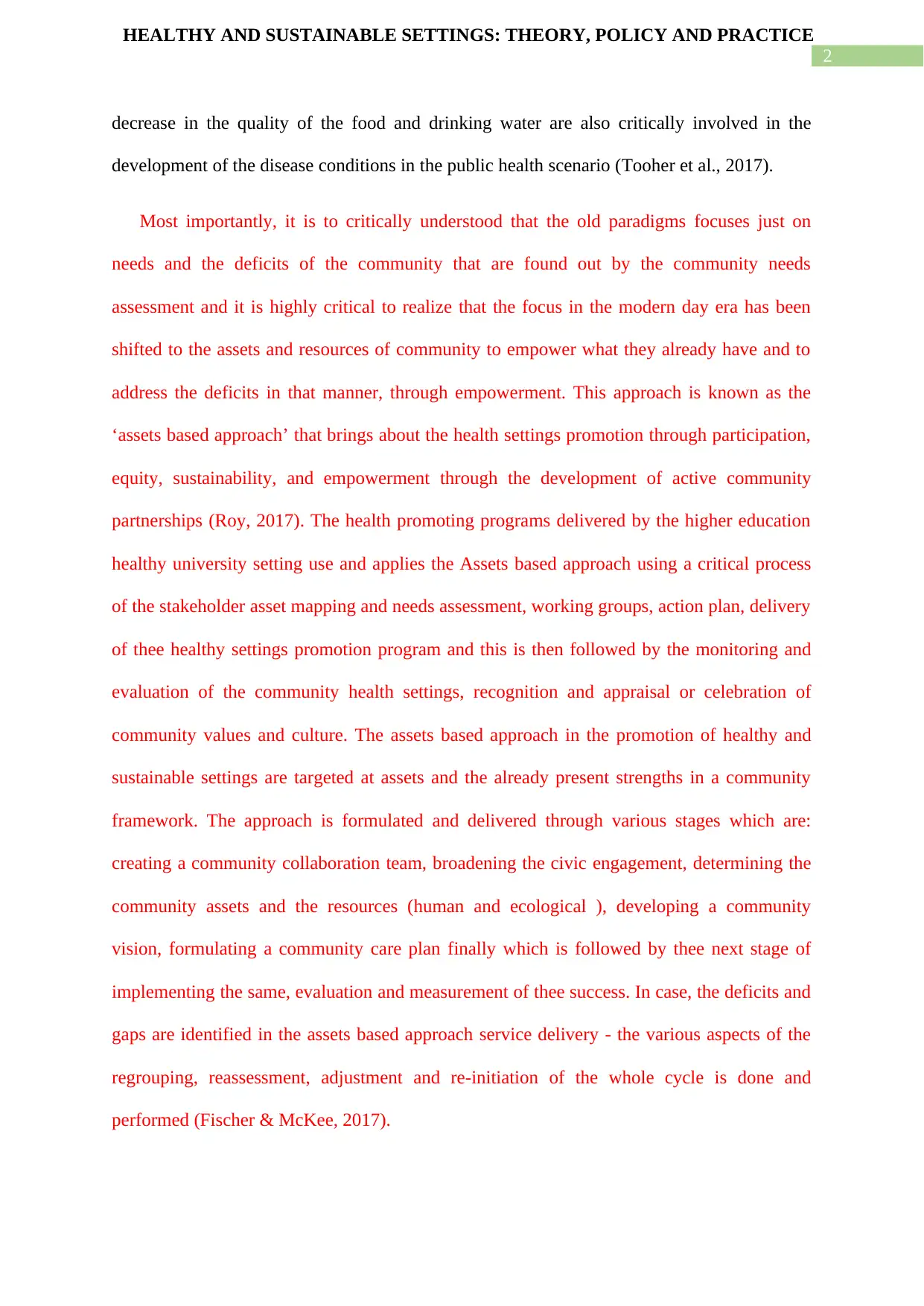
2
HEALTHY AND SUSTAINABLE SETTINGS: THEORY, POLICY AND PRACTICE
decrease in the quality of the food and drinking water are also critically involved in the
development of the disease conditions in the public health scenario (Tooher et al., 2017).
Most importantly, it is to critically understood that the old paradigms focuses just on
needs and the deficits of the community that are found out by the community needs
assessment and it is highly critical to realize that the focus in the modern day era has been
shifted to the assets and resources of community to empower what they already have and to
address the deficits in that manner, through empowerment. This approach is known as the
‘assets based approach’ that brings about the health settings promotion through participation,
equity, sustainability, and empowerment through the development of active community
partnerships (Roy, 2017). The health promoting programs delivered by the higher education
healthy university setting use and applies the Assets based approach using a critical process
of the stakeholder asset mapping and needs assessment, working groups, action plan, delivery
of thee healthy settings promotion program and this is then followed by the monitoring and
evaluation of the community health settings, recognition and appraisal or celebration of
community values and culture. The assets based approach in the promotion of healthy and
sustainable settings are targeted at assets and the already present strengths in a community
framework. The approach is formulated and delivered through various stages which are:
creating a community collaboration team, broadening the civic engagement, determining the
community assets and the resources (human and ecological ), developing a community
vision, formulating a community care plan finally which is followed by thee next stage of
implementing the same, evaluation and measurement of thee success. In case, the deficits and
gaps are identified in the assets based approach service delivery - the various aspects of the
regrouping, reassessment, adjustment and re-initiation of the whole cycle is done and
performed (Fischer & McKee, 2017).
HEALTHY AND SUSTAINABLE SETTINGS: THEORY, POLICY AND PRACTICE
decrease in the quality of the food and drinking water are also critically involved in the
development of the disease conditions in the public health scenario (Tooher et al., 2017).
Most importantly, it is to critically understood that the old paradigms focuses just on
needs and the deficits of the community that are found out by the community needs
assessment and it is highly critical to realize that the focus in the modern day era has been
shifted to the assets and resources of community to empower what they already have and to
address the deficits in that manner, through empowerment. This approach is known as the
‘assets based approach’ that brings about the health settings promotion through participation,
equity, sustainability, and empowerment through the development of active community
partnerships (Roy, 2017). The health promoting programs delivered by the higher education
healthy university setting use and applies the Assets based approach using a critical process
of the stakeholder asset mapping and needs assessment, working groups, action plan, delivery
of thee healthy settings promotion program and this is then followed by the monitoring and
evaluation of the community health settings, recognition and appraisal or celebration of
community values and culture. The assets based approach in the promotion of healthy and
sustainable settings are targeted at assets and the already present strengths in a community
framework. The approach is formulated and delivered through various stages which are:
creating a community collaboration team, broadening the civic engagement, determining the
community assets and the resources (human and ecological ), developing a community
vision, formulating a community care plan finally which is followed by thee next stage of
implementing the same, evaluation and measurement of thee success. In case, the deficits and
gaps are identified in the assets based approach service delivery - the various aspects of the
regrouping, reassessment, adjustment and re-initiation of the whole cycle is done and
performed (Fischer & McKee, 2017).
⊘ This is a preview!⊘
Do you want full access?
Subscribe today to unlock all pages.

Trusted by 1+ million students worldwide
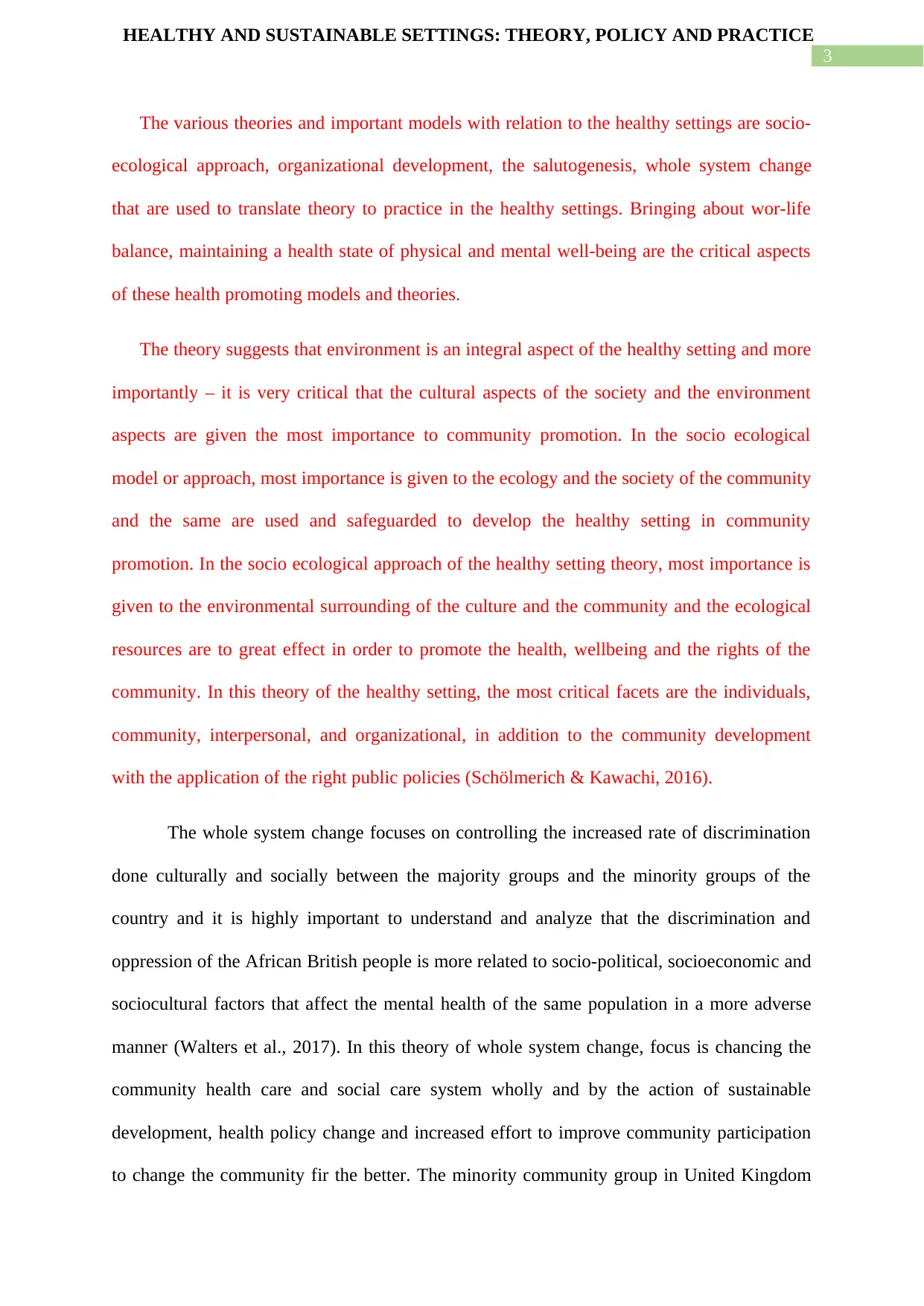
3
HEALTHY AND SUSTAINABLE SETTINGS: THEORY, POLICY AND PRACTICE
The various theories and important models with relation to the healthy settings are socio-
ecological approach, organizational development, the salutogenesis, whole system change
that are used to translate theory to practice in the healthy settings. Bringing about wor-life
balance, maintaining a health state of physical and mental well-being are the critical aspects
of these health promoting models and theories.
The theory suggests that environment is an integral aspect of the healthy setting and more
importantly – it is very critical that the cultural aspects of the society and the environment
aspects are given the most importance to community promotion. In the socio ecological
model or approach, most importance is given to the ecology and the society of the community
and the same are used and safeguarded to develop the healthy setting in community
promotion. In the socio ecological approach of the healthy setting theory, most importance is
given to the environmental surrounding of the culture and the community and the ecological
resources are to great effect in order to promote the health, wellbeing and the rights of the
community. In this theory of the healthy setting, the most critical facets are the individuals,
community, interpersonal, and organizational, in addition to the community development
with the application of the right public policies (Schölmerich & Kawachi, 2016).
The whole system change focuses on controlling the increased rate of discrimination
done culturally and socially between the majority groups and the minority groups of the
country and it is highly important to understand and analyze that the discrimination and
oppression of the African British people is more related to socio-political, socioeconomic and
sociocultural factors that affect the mental health of the same population in a more adverse
manner (Walters et al., 2017). In this theory of whole system change, focus is chancing the
community health care and social care system wholly and by the action of sustainable
development, health policy change and increased effort to improve community participation
to change the community fir the better. The minority community group in United Kingdom
HEALTHY AND SUSTAINABLE SETTINGS: THEORY, POLICY AND PRACTICE
The various theories and important models with relation to the healthy settings are socio-
ecological approach, organizational development, the salutogenesis, whole system change
that are used to translate theory to practice in the healthy settings. Bringing about wor-life
balance, maintaining a health state of physical and mental well-being are the critical aspects
of these health promoting models and theories.
The theory suggests that environment is an integral aspect of the healthy setting and more
importantly – it is very critical that the cultural aspects of the society and the environment
aspects are given the most importance to community promotion. In the socio ecological
model or approach, most importance is given to the ecology and the society of the community
and the same are used and safeguarded to develop the healthy setting in community
promotion. In the socio ecological approach of the healthy setting theory, most importance is
given to the environmental surrounding of the culture and the community and the ecological
resources are to great effect in order to promote the health, wellbeing and the rights of the
community. In this theory of the healthy setting, the most critical facets are the individuals,
community, interpersonal, and organizational, in addition to the community development
with the application of the right public policies (Schölmerich & Kawachi, 2016).
The whole system change focuses on controlling the increased rate of discrimination
done culturally and socially between the majority groups and the minority groups of the
country and it is highly important to understand and analyze that the discrimination and
oppression of the African British people is more related to socio-political, socioeconomic and
sociocultural factors that affect the mental health of the same population in a more adverse
manner (Walters et al., 2017). In this theory of whole system change, focus is chancing the
community health care and social care system wholly and by the action of sustainable
development, health policy change and increased effort to improve community participation
to change the community fir the better. The minority community group in United Kingdom
Paraphrase This Document
Need a fresh take? Get an instant paraphrase of this document with our AI Paraphraser
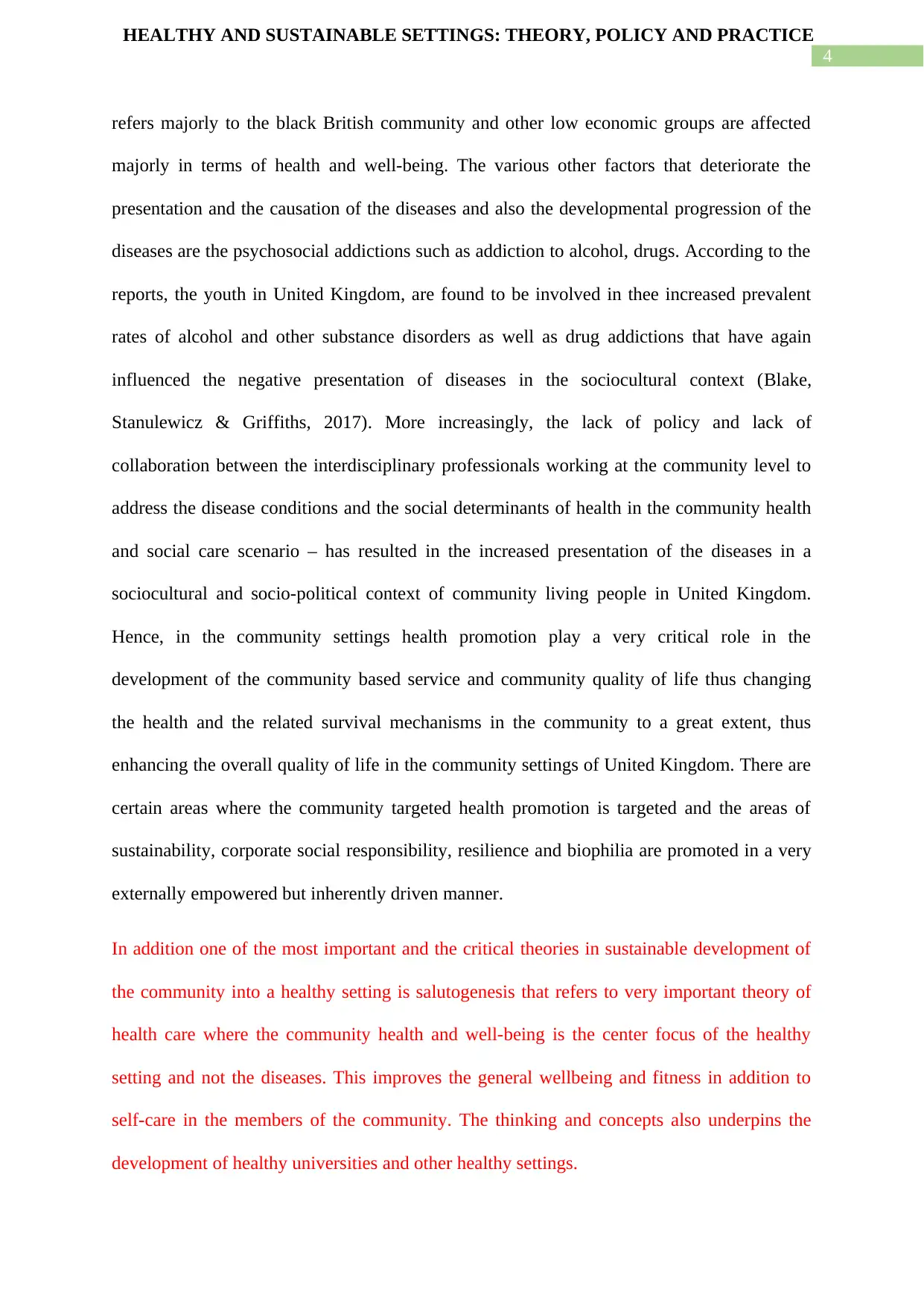
4
HEALTHY AND SUSTAINABLE SETTINGS: THEORY, POLICY AND PRACTICE
refers majorly to the black British community and other low economic groups are affected
majorly in terms of health and well-being. The various other factors that deteriorate the
presentation and the causation of the diseases and also the developmental progression of the
diseases are the psychosocial addictions such as addiction to alcohol, drugs. According to the
reports, the youth in United Kingdom, are found to be involved in thee increased prevalent
rates of alcohol and other substance disorders as well as drug addictions that have again
influenced the negative presentation of diseases in the sociocultural context (Blake,
Stanulewicz & Griffiths, 2017). More increasingly, the lack of policy and lack of
collaboration between the interdisciplinary professionals working at the community level to
address the disease conditions and the social determinants of health in the community health
and social care scenario – has resulted in the increased presentation of the diseases in a
sociocultural and socio-political context of community living people in United Kingdom.
Hence, in the community settings health promotion play a very critical role in the
development of the community based service and community quality of life thus changing
the health and the related survival mechanisms in the community to a great extent, thus
enhancing the overall quality of life in the community settings of United Kingdom. There are
certain areas where the community targeted health promotion is targeted and the areas of
sustainability, corporate social responsibility, resilience and biophilia are promoted in a very
externally empowered but inherently driven manner.
In addition one of the most important and the critical theories in sustainable development of
the community into a healthy setting is salutogenesis that refers to very important theory of
health care where the community health and well-being is the center focus of the healthy
setting and not the diseases. This improves the general wellbeing and fitness in addition to
self-care in the members of the community. The thinking and concepts also underpins the
development of healthy universities and other healthy settings.
HEALTHY AND SUSTAINABLE SETTINGS: THEORY, POLICY AND PRACTICE
refers majorly to the black British community and other low economic groups are affected
majorly in terms of health and well-being. The various other factors that deteriorate the
presentation and the causation of the diseases and also the developmental progression of the
diseases are the psychosocial addictions such as addiction to alcohol, drugs. According to the
reports, the youth in United Kingdom, are found to be involved in thee increased prevalent
rates of alcohol and other substance disorders as well as drug addictions that have again
influenced the negative presentation of diseases in the sociocultural context (Blake,
Stanulewicz & Griffiths, 2017). More increasingly, the lack of policy and lack of
collaboration between the interdisciplinary professionals working at the community level to
address the disease conditions and the social determinants of health in the community health
and social care scenario – has resulted in the increased presentation of the diseases in a
sociocultural and socio-political context of community living people in United Kingdom.
Hence, in the community settings health promotion play a very critical role in the
development of the community based service and community quality of life thus changing
the health and the related survival mechanisms in the community to a great extent, thus
enhancing the overall quality of life in the community settings of United Kingdom. There are
certain areas where the community targeted health promotion is targeted and the areas of
sustainability, corporate social responsibility, resilience and biophilia are promoted in a very
externally empowered but inherently driven manner.
In addition one of the most important and the critical theories in sustainable development of
the community into a healthy setting is salutogenesis that refers to very important theory of
health care where the community health and well-being is the center focus of the healthy
setting and not the diseases. This improves the general wellbeing and fitness in addition to
self-care in the members of the community. The thinking and concepts also underpins the
development of healthy universities and other healthy settings.
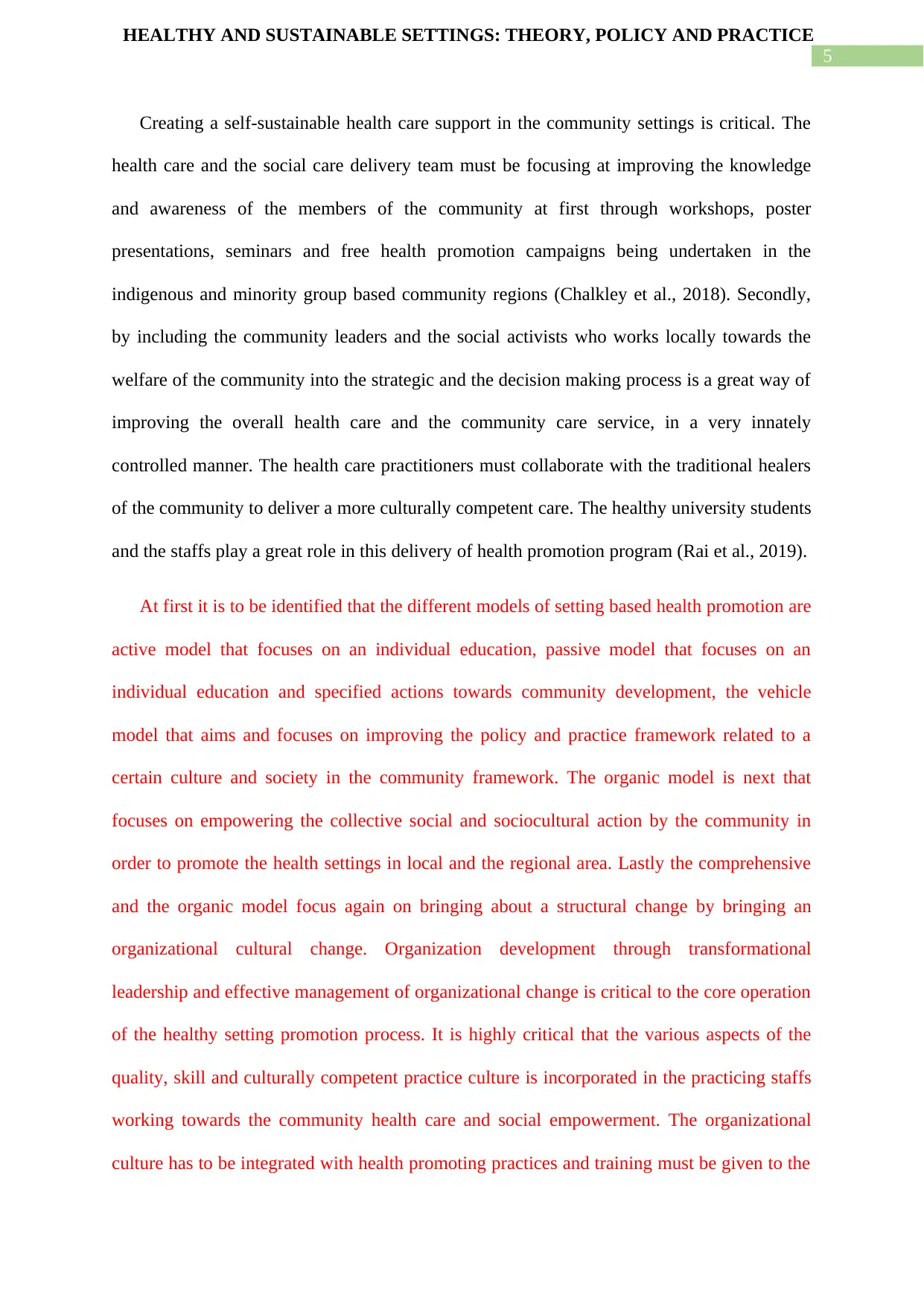
5
HEALTHY AND SUSTAINABLE SETTINGS: THEORY, POLICY AND PRACTICE
Creating a self-sustainable health care support in the community settings is critical. The
health care and the social care delivery team must be focusing at improving the knowledge
and awareness of the members of the community at first through workshops, poster
presentations, seminars and free health promotion campaigns being undertaken in the
indigenous and minority group based community regions (Chalkley et al., 2018). Secondly,
by including the community leaders and the social activists who works locally towards the
welfare of the community into the strategic and the decision making process is a great way of
improving the overall health care and the community care service, in a very innately
controlled manner. The health care practitioners must collaborate with the traditional healers
of the community to deliver a more culturally competent care. The healthy university students
and the staffs play a great role in this delivery of health promotion program (Rai et al., 2019).
At first it is to be identified that the different models of setting based health promotion are
active model that focuses on an individual education, passive model that focuses on an
individual education and specified actions towards community development, the vehicle
model that aims and focuses on improving the policy and practice framework related to a
certain culture and society in the community framework. The organic model is next that
focuses on empowering the collective social and sociocultural action by the community in
order to promote the health settings in local and the regional area. Lastly the comprehensive
and the organic model focus again on bringing about a structural change by bringing an
organizational cultural change. Organization development through transformational
leadership and effective management of organizational change is critical to the core operation
of the healthy setting promotion process. It is highly critical that the various aspects of the
quality, skill and culturally competent practice culture is incorporated in the practicing staffs
working towards the community health care and social empowerment. The organizational
culture has to be integrated with health promoting practices and training must be given to the
HEALTHY AND SUSTAINABLE SETTINGS: THEORY, POLICY AND PRACTICE
Creating a self-sustainable health care support in the community settings is critical. The
health care and the social care delivery team must be focusing at improving the knowledge
and awareness of the members of the community at first through workshops, poster
presentations, seminars and free health promotion campaigns being undertaken in the
indigenous and minority group based community regions (Chalkley et al., 2018). Secondly,
by including the community leaders and the social activists who works locally towards the
welfare of the community into the strategic and the decision making process is a great way of
improving the overall health care and the community care service, in a very innately
controlled manner. The health care practitioners must collaborate with the traditional healers
of the community to deliver a more culturally competent care. The healthy university students
and the staffs play a great role in this delivery of health promotion program (Rai et al., 2019).
At first it is to be identified that the different models of setting based health promotion are
active model that focuses on an individual education, passive model that focuses on an
individual education and specified actions towards community development, the vehicle
model that aims and focuses on improving the policy and practice framework related to a
certain culture and society in the community framework. The organic model is next that
focuses on empowering the collective social and sociocultural action by the community in
order to promote the health settings in local and the regional area. Lastly the comprehensive
and the organic model focus again on bringing about a structural change by bringing an
organizational cultural change. Organization development through transformational
leadership and effective management of organizational change is critical to the core operation
of the healthy setting promotion process. It is highly critical that the various aspects of the
quality, skill and culturally competent practice culture is incorporated in the practicing staffs
working towards the community health care and social empowerment. The organizational
culture has to be integrated with health promoting practices and training must be given to the
⊘ This is a preview!⊘
Do you want full access?
Subscribe today to unlock all pages.

Trusted by 1+ million students worldwide
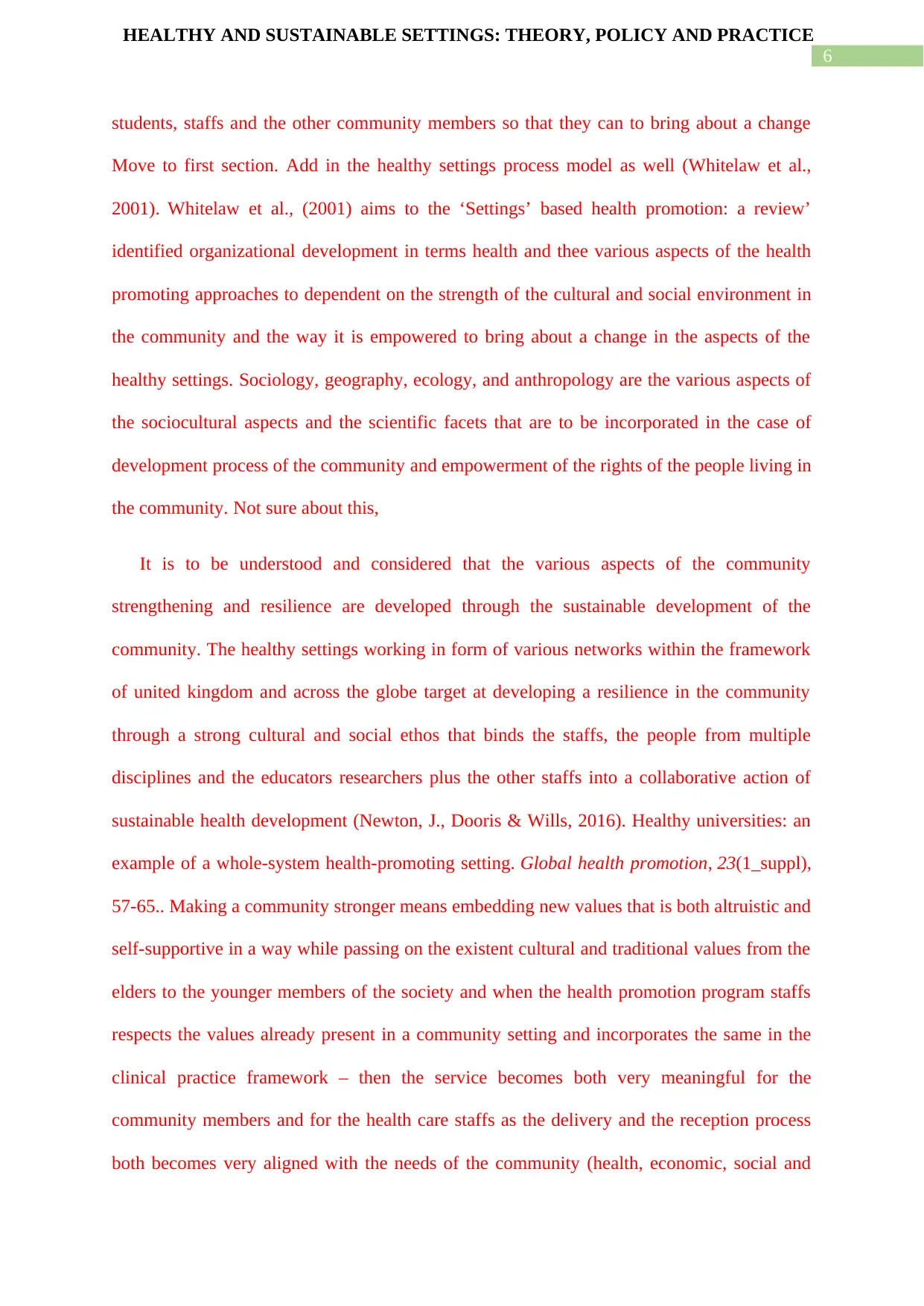
6
HEALTHY AND SUSTAINABLE SETTINGS: THEORY, POLICY AND PRACTICE
students, staffs and the other community members so that they can to bring about a change
Move to first section. Add in the healthy settings process model as well (Whitelaw et al.,
2001). Whitelaw et al., (2001) aims to the ‘Settings’ based health promotion: a review’
identified organizational development in terms health and thee various aspects of the health
promoting approaches to dependent on the strength of the cultural and social environment in
the community and the way it is empowered to bring about a change in the aspects of the
healthy settings. Sociology, geography, ecology, and anthropology are the various aspects of
the sociocultural aspects and the scientific facets that are to be incorporated in the case of
development process of the community and empowerment of the rights of the people living in
the community. Not sure about this,
It is to be understood and considered that the various aspects of the community
strengthening and resilience are developed through the sustainable development of the
community. The healthy settings working in form of various networks within the framework
of united kingdom and across the globe target at developing a resilience in the community
through a strong cultural and social ethos that binds the staffs, the people from multiple
disciplines and the educators researchers plus the other staffs into a collaborative action of
sustainable health development (Newton, J., Dooris & Wills, 2016). Healthy universities: an
example of a whole-system health-promoting setting. Global health promotion, 23(1_suppl),
57-65.. Making a community stronger means embedding new values that is both altruistic and
self-supportive in a way while passing on the existent cultural and traditional values from the
elders to the younger members of the society and when the health promotion program staffs
respects the values already present in a community setting and incorporates the same in the
clinical practice framework – then the service becomes both very meaningful for the
community members and for the health care staffs as the delivery and the reception process
both becomes very aligned with the needs of the community (health, economic, social and
HEALTHY AND SUSTAINABLE SETTINGS: THEORY, POLICY AND PRACTICE
students, staffs and the other community members so that they can to bring about a change
Move to first section. Add in the healthy settings process model as well (Whitelaw et al.,
2001). Whitelaw et al., (2001) aims to the ‘Settings’ based health promotion: a review’
identified organizational development in terms health and thee various aspects of the health
promoting approaches to dependent on the strength of the cultural and social environment in
the community and the way it is empowered to bring about a change in the aspects of the
healthy settings. Sociology, geography, ecology, and anthropology are the various aspects of
the sociocultural aspects and the scientific facets that are to be incorporated in the case of
development process of the community and empowerment of the rights of the people living in
the community. Not sure about this,
It is to be understood and considered that the various aspects of the community
strengthening and resilience are developed through the sustainable development of the
community. The healthy settings working in form of various networks within the framework
of united kingdom and across the globe target at developing a resilience in the community
through a strong cultural and social ethos that binds the staffs, the people from multiple
disciplines and the educators researchers plus the other staffs into a collaborative action of
sustainable health development (Newton, J., Dooris & Wills, 2016). Healthy universities: an
example of a whole-system health-promoting setting. Global health promotion, 23(1_suppl),
57-65.. Making a community stronger means embedding new values that is both altruistic and
self-supportive in a way while passing on the existent cultural and traditional values from the
elders to the younger members of the society and when the health promotion program staffs
respects the values already present in a community setting and incorporates the same in the
clinical practice framework – then the service becomes both very meaningful for the
community members and for the health care staffs as the delivery and the reception process
both becomes very aligned with the needs of the community (health, economic, social and
Paraphrase This Document
Need a fresh take? Get an instant paraphrase of this document with our AI Paraphraser
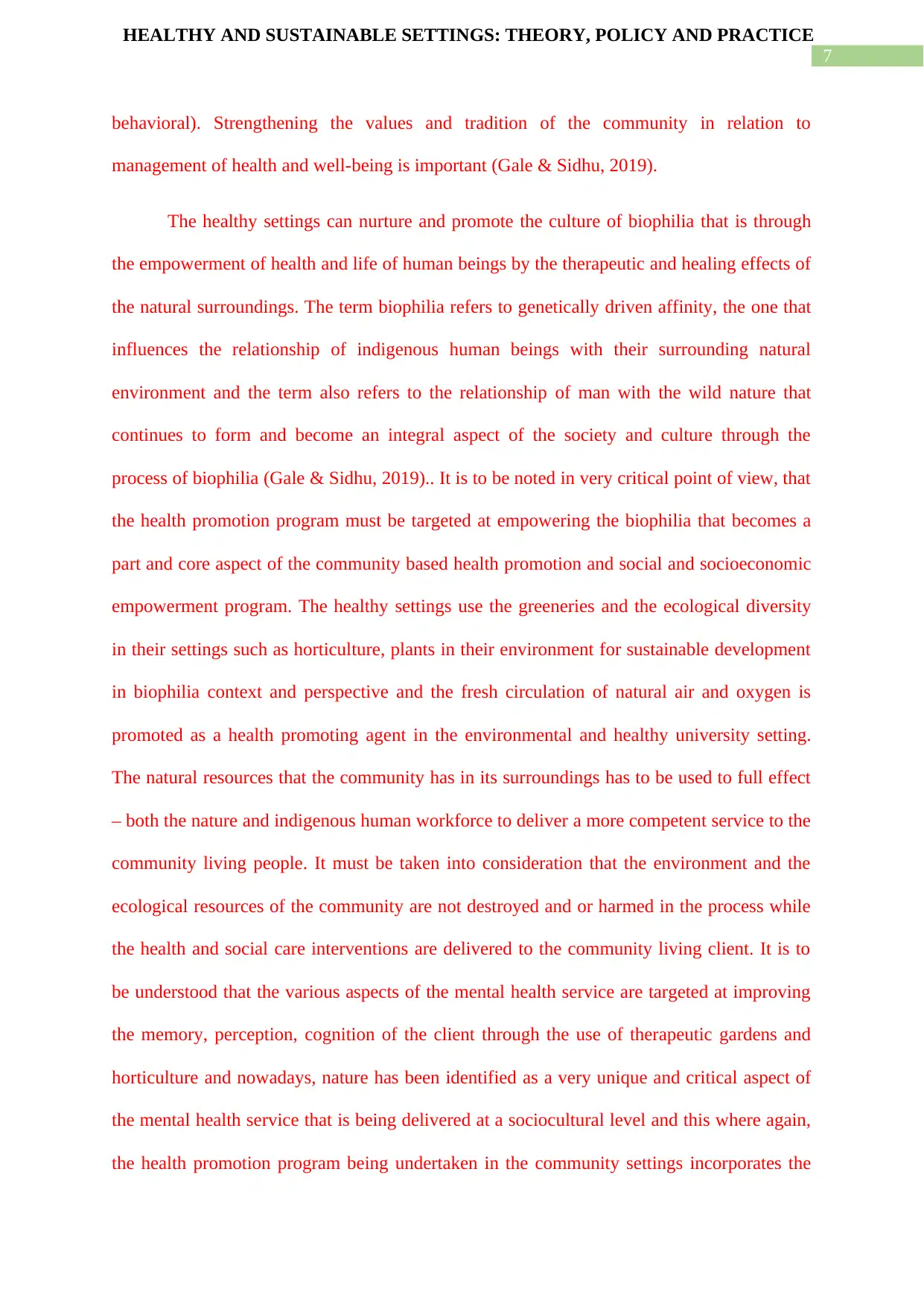
7
HEALTHY AND SUSTAINABLE SETTINGS: THEORY, POLICY AND PRACTICE
behavioral). Strengthening the values and tradition of the community in relation to
management of health and well-being is important (Gale & Sidhu, 2019).
The healthy settings can nurture and promote the culture of biophilia that is through
the empowerment of health and life of human beings by the therapeutic and healing effects of
the natural surroundings. The term biophilia refers to genetically driven affinity, the one that
influences the relationship of indigenous human beings with their surrounding natural
environment and the term also refers to the relationship of man with the wild nature that
continues to form and become an integral aspect of the society and culture through the
process of biophilia (Gale & Sidhu, 2019).. It is to be noted in very critical point of view, that
the health promotion program must be targeted at empowering the biophilia that becomes a
part and core aspect of the community based health promotion and social and socioeconomic
empowerment program. The healthy settings use the greeneries and the ecological diversity
in their settings such as horticulture, plants in their environment for sustainable development
in biophilia context and perspective and the fresh circulation of natural air and oxygen is
promoted as a health promoting agent in the environmental and healthy university setting.
The natural resources that the community has in its surroundings has to be used to full effect
– both the nature and indigenous human workforce to deliver a more competent service to the
community living people. It must be taken into consideration that the environment and the
ecological resources of the community are not destroyed and or harmed in the process while
the health and social care interventions are delivered to the community living client. It is to
be understood that the various aspects of the mental health service are targeted at improving
the memory, perception, cognition of the client through the use of therapeutic gardens and
horticulture and nowadays, nature has been identified as a very unique and critical aspect of
the mental health service that is being delivered at a sociocultural level and this where again,
the health promotion program being undertaken in the community settings incorporates the
HEALTHY AND SUSTAINABLE SETTINGS: THEORY, POLICY AND PRACTICE
behavioral). Strengthening the values and tradition of the community in relation to
management of health and well-being is important (Gale & Sidhu, 2019).
The healthy settings can nurture and promote the culture of biophilia that is through
the empowerment of health and life of human beings by the therapeutic and healing effects of
the natural surroundings. The term biophilia refers to genetically driven affinity, the one that
influences the relationship of indigenous human beings with their surrounding natural
environment and the term also refers to the relationship of man with the wild nature that
continues to form and become an integral aspect of the society and culture through the
process of biophilia (Gale & Sidhu, 2019).. It is to be noted in very critical point of view, that
the health promotion program must be targeted at empowering the biophilia that becomes a
part and core aspect of the community based health promotion and social and socioeconomic
empowerment program. The healthy settings use the greeneries and the ecological diversity
in their settings such as horticulture, plants in their environment for sustainable development
in biophilia context and perspective and the fresh circulation of natural air and oxygen is
promoted as a health promoting agent in the environmental and healthy university setting.
The natural resources that the community has in its surroundings has to be used to full effect
– both the nature and indigenous human workforce to deliver a more competent service to the
community living people. It must be taken into consideration that the environment and the
ecological resources of the community are not destroyed and or harmed in the process while
the health and social care interventions are delivered to the community living client. It is to
be understood that the various aspects of the mental health service are targeted at improving
the memory, perception, cognition of the client through the use of therapeutic gardens and
horticulture and nowadays, nature has been identified as a very unique and critical aspect of
the mental health service that is being delivered at a sociocultural level and this where again,
the health promotion program being undertaken in the community settings incorporates the
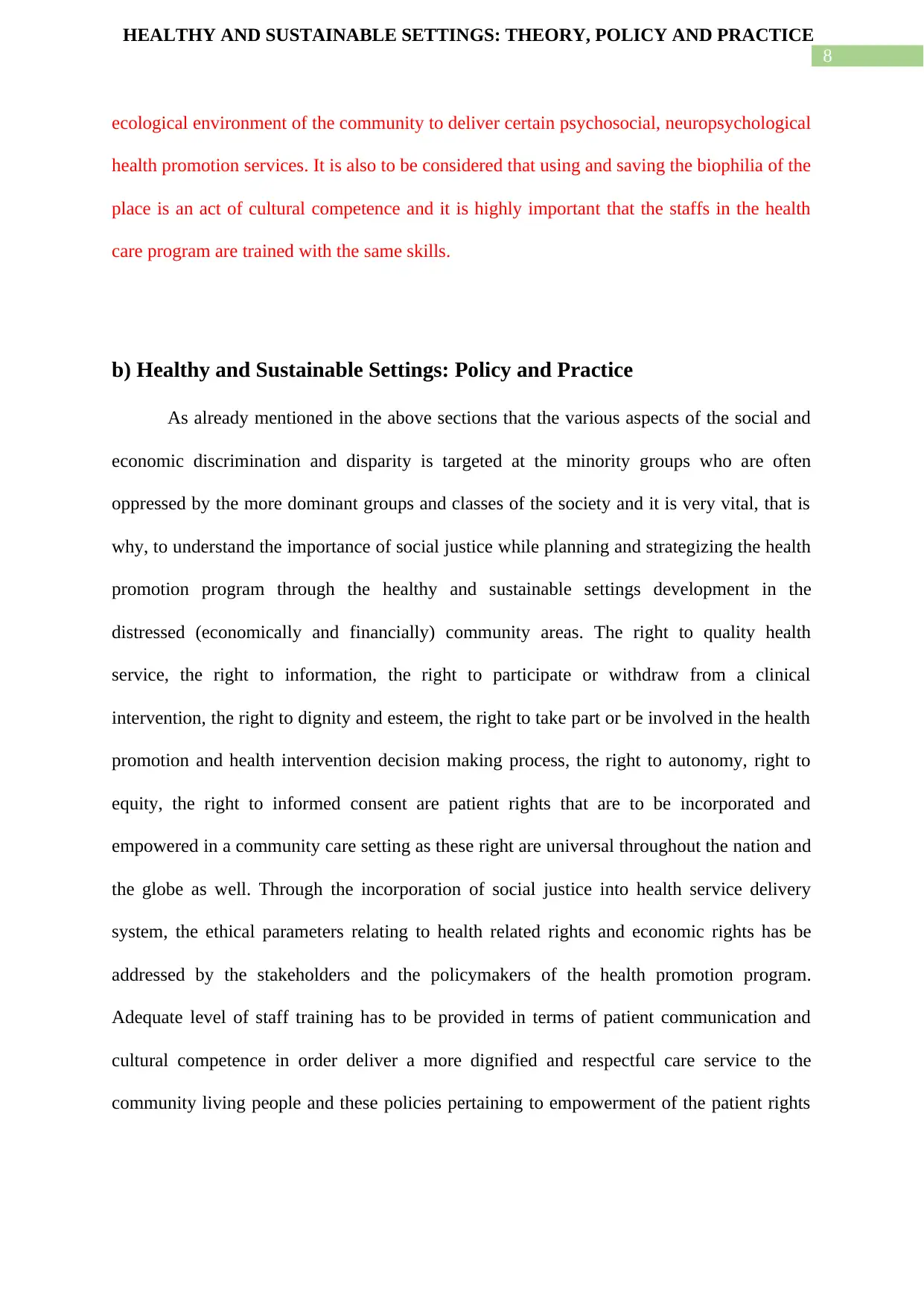
8
HEALTHY AND SUSTAINABLE SETTINGS: THEORY, POLICY AND PRACTICE
ecological environment of the community to deliver certain psychosocial, neuropsychological
health promotion services. It is also to be considered that using and saving the biophilia of the
place is an act of cultural competence and it is highly important that the staffs in the health
care program are trained with the same skills.
b) Healthy and Sustainable Settings: Policy and Practice
As already mentioned in the above sections that the various aspects of the social and
economic discrimination and disparity is targeted at the minority groups who are often
oppressed by the more dominant groups and classes of the society and it is very vital, that is
why, to understand the importance of social justice while planning and strategizing the health
promotion program through the healthy and sustainable settings development in the
distressed (economically and financially) community areas. The right to quality health
service, the right to information, the right to participate or withdraw from a clinical
intervention, the right to dignity and esteem, the right to take part or be involved in the health
promotion and health intervention decision making process, the right to autonomy, right to
equity, the right to informed consent are patient rights that are to be incorporated and
empowered in a community care setting as these right are universal throughout the nation and
the globe as well. Through the incorporation of social justice into health service delivery
system, the ethical parameters relating to health related rights and economic rights has be
addressed by the stakeholders and the policymakers of the health promotion program.
Adequate level of staff training has to be provided in terms of patient communication and
cultural competence in order deliver a more dignified and respectful care service to the
community living people and these policies pertaining to empowerment of the patient rights
HEALTHY AND SUSTAINABLE SETTINGS: THEORY, POLICY AND PRACTICE
ecological environment of the community to deliver certain psychosocial, neuropsychological
health promotion services. It is also to be considered that using and saving the biophilia of the
place is an act of cultural competence and it is highly important that the staffs in the health
care program are trained with the same skills.
b) Healthy and Sustainable Settings: Policy and Practice
As already mentioned in the above sections that the various aspects of the social and
economic discrimination and disparity is targeted at the minority groups who are often
oppressed by the more dominant groups and classes of the society and it is very vital, that is
why, to understand the importance of social justice while planning and strategizing the health
promotion program through the healthy and sustainable settings development in the
distressed (economically and financially) community areas. The right to quality health
service, the right to information, the right to participate or withdraw from a clinical
intervention, the right to dignity and esteem, the right to take part or be involved in the health
promotion and health intervention decision making process, the right to autonomy, right to
equity, the right to informed consent are patient rights that are to be incorporated and
empowered in a community care setting as these right are universal throughout the nation and
the globe as well. Through the incorporation of social justice into health service delivery
system, the ethical parameters relating to health related rights and economic rights has be
addressed by the stakeholders and the policymakers of the health promotion program.
Adequate level of staff training has to be provided in terms of patient communication and
cultural competence in order deliver a more dignified and respectful care service to the
community living people and these policies pertaining to empowerment of the patient rights
⊘ This is a preview!⊘
Do you want full access?
Subscribe today to unlock all pages.

Trusted by 1+ million students worldwide
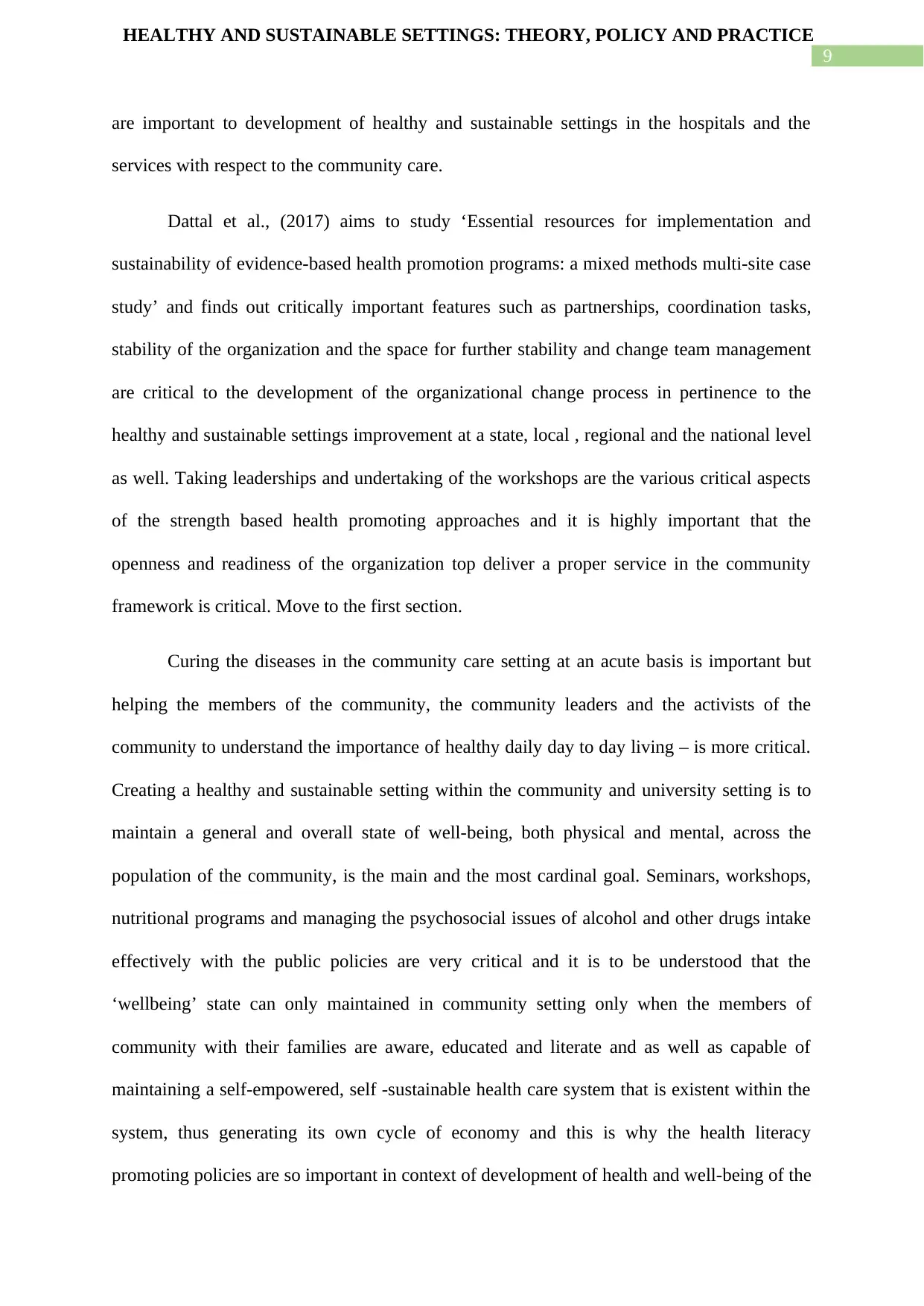
9
HEALTHY AND SUSTAINABLE SETTINGS: THEORY, POLICY AND PRACTICE
are important to development of healthy and sustainable settings in the hospitals and the
services with respect to the community care.
Dattal et al., (2017) aims to study ‘Essential resources for implementation and
sustainability of evidence-based health promotion programs: a mixed methods multi-site case
study’ and finds out critically important features such as partnerships, coordination tasks,
stability of the organization and the space for further stability and change team management
are critical to the development of the organizational change process in pertinence to the
healthy and sustainable settings improvement at a state, local , regional and the national level
as well. Taking leaderships and undertaking of the workshops are the various critical aspects
of the strength based health promoting approaches and it is highly important that the
openness and readiness of the organization top deliver a proper service in the community
framework is critical. Move to the first section.
Curing the diseases in the community care setting at an acute basis is important but
helping the members of the community, the community leaders and the activists of the
community to understand the importance of healthy daily day to day living – is more critical.
Creating a healthy and sustainable setting within the community and university setting is to
maintain a general and overall state of well-being, both physical and mental, across the
population of the community, is the main and the most cardinal goal. Seminars, workshops,
nutritional programs and managing the psychosocial issues of alcohol and other drugs intake
effectively with the public policies are very critical and it is to be understood that the
‘wellbeing’ state can only maintained in community setting only when the members of
community with their families are aware, educated and literate and as well as capable of
maintaining a self-empowered, self -sustainable health care system that is existent within the
system, thus generating its own cycle of economy and this is why the health literacy
promoting policies are so important in context of development of health and well-being of the
HEALTHY AND SUSTAINABLE SETTINGS: THEORY, POLICY AND PRACTICE
are important to development of healthy and sustainable settings in the hospitals and the
services with respect to the community care.
Dattal et al., (2017) aims to study ‘Essential resources for implementation and
sustainability of evidence-based health promotion programs: a mixed methods multi-site case
study’ and finds out critically important features such as partnerships, coordination tasks,
stability of the organization and the space for further stability and change team management
are critical to the development of the organizational change process in pertinence to the
healthy and sustainable settings improvement at a state, local , regional and the national level
as well. Taking leaderships and undertaking of the workshops are the various critical aspects
of the strength based health promoting approaches and it is highly important that the
openness and readiness of the organization top deliver a proper service in the community
framework is critical. Move to the first section.
Curing the diseases in the community care setting at an acute basis is important but
helping the members of the community, the community leaders and the activists of the
community to understand the importance of healthy daily day to day living – is more critical.
Creating a healthy and sustainable setting within the community and university setting is to
maintain a general and overall state of well-being, both physical and mental, across the
population of the community, is the main and the most cardinal goal. Seminars, workshops,
nutritional programs and managing the psychosocial issues of alcohol and other drugs intake
effectively with the public policies are very critical and it is to be understood that the
‘wellbeing’ state can only maintained in community setting only when the members of
community with their families are aware, educated and literate and as well as capable of
maintaining a self-empowered, self -sustainable health care system that is existent within the
system, thus generating its own cycle of economy and this is why the health literacy
promoting policies are so important in context of development of health and well-being of the
Paraphrase This Document
Need a fresh take? Get an instant paraphrase of this document with our AI Paraphraser
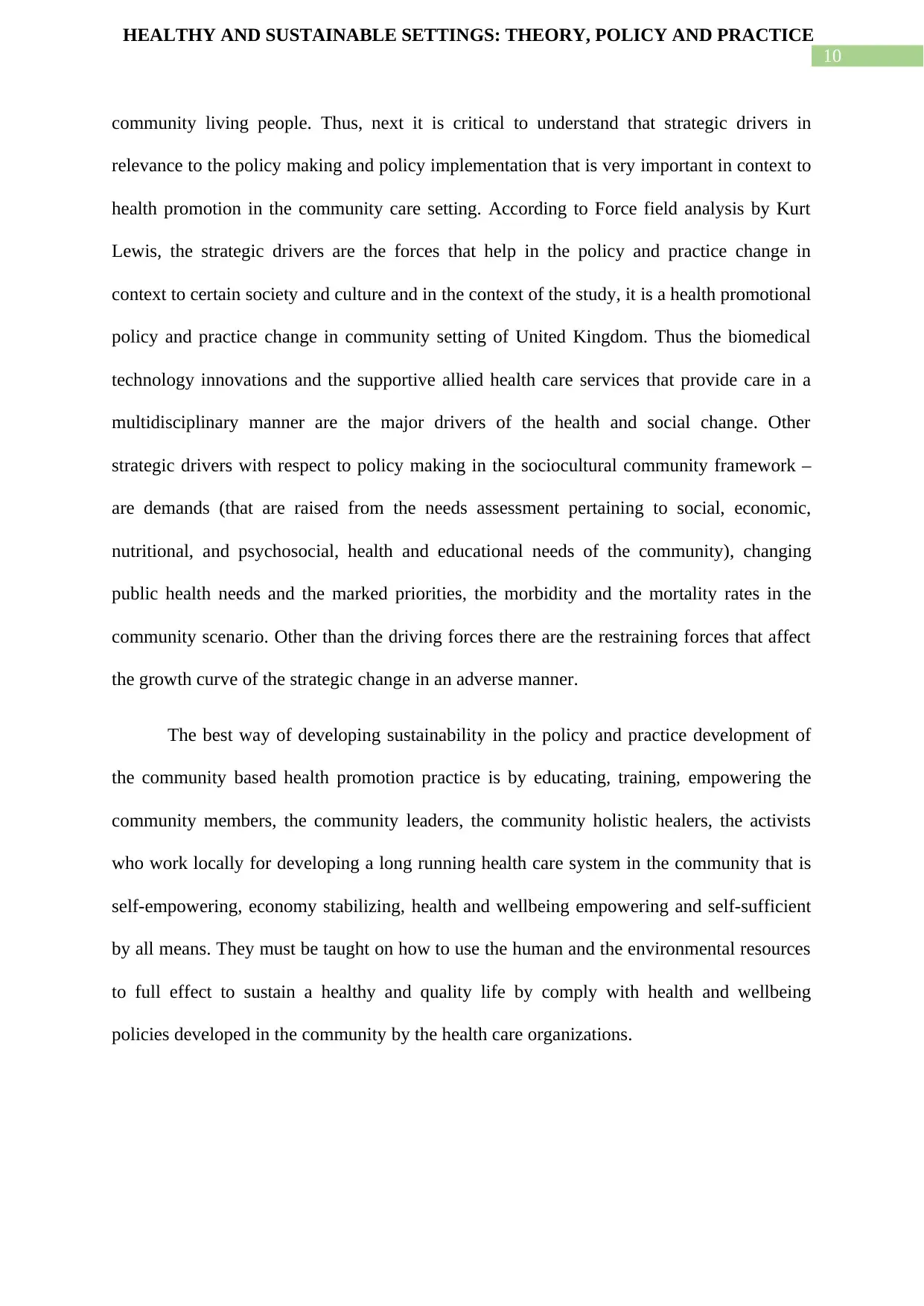
10
HEALTHY AND SUSTAINABLE SETTINGS: THEORY, POLICY AND PRACTICE
community living people. Thus, next it is critical to understand that strategic drivers in
relevance to the policy making and policy implementation that is very important in context to
health promotion in the community care setting. According to Force field analysis by Kurt
Lewis, the strategic drivers are the forces that help in the policy and practice change in
context to certain society and culture and in the context of the study, it is a health promotional
policy and practice change in community setting of United Kingdom. Thus the biomedical
technology innovations and the supportive allied health care services that provide care in a
multidisciplinary manner are the major drivers of the health and social change. Other
strategic drivers with respect to policy making in the sociocultural community framework –
are demands (that are raised from the needs assessment pertaining to social, economic,
nutritional, and psychosocial, health and educational needs of the community), changing
public health needs and the marked priorities, the morbidity and the mortality rates in the
community scenario. Other than the driving forces there are the restraining forces that affect
the growth curve of the strategic change in an adverse manner.
The best way of developing sustainability in the policy and practice development of
the community based health promotion practice is by educating, training, empowering the
community members, the community leaders, the community holistic healers, the activists
who work locally for developing a long running health care system in the community that is
self-empowering, economy stabilizing, health and wellbeing empowering and self-sufficient
by all means. They must be taught on how to use the human and the environmental resources
to full effect to sustain a healthy and quality life by comply with health and wellbeing
policies developed in the community by the health care organizations.
HEALTHY AND SUSTAINABLE SETTINGS: THEORY, POLICY AND PRACTICE
community living people. Thus, next it is critical to understand that strategic drivers in
relevance to the policy making and policy implementation that is very important in context to
health promotion in the community care setting. According to Force field analysis by Kurt
Lewis, the strategic drivers are the forces that help in the policy and practice change in
context to certain society and culture and in the context of the study, it is a health promotional
policy and practice change in community setting of United Kingdom. Thus the biomedical
technology innovations and the supportive allied health care services that provide care in a
multidisciplinary manner are the major drivers of the health and social change. Other
strategic drivers with respect to policy making in the sociocultural community framework –
are demands (that are raised from the needs assessment pertaining to social, economic,
nutritional, and psychosocial, health and educational needs of the community), changing
public health needs and the marked priorities, the morbidity and the mortality rates in the
community scenario. Other than the driving forces there are the restraining forces that affect
the growth curve of the strategic change in an adverse manner.
The best way of developing sustainability in the policy and practice development of
the community based health promotion practice is by educating, training, empowering the
community members, the community leaders, the community holistic healers, the activists
who work locally for developing a long running health care system in the community that is
self-empowering, economy stabilizing, health and wellbeing empowering and self-sufficient
by all means. They must be taught on how to use the human and the environmental resources
to full effect to sustain a healthy and quality life by comply with health and wellbeing
policies developed in the community by the health care organizations.
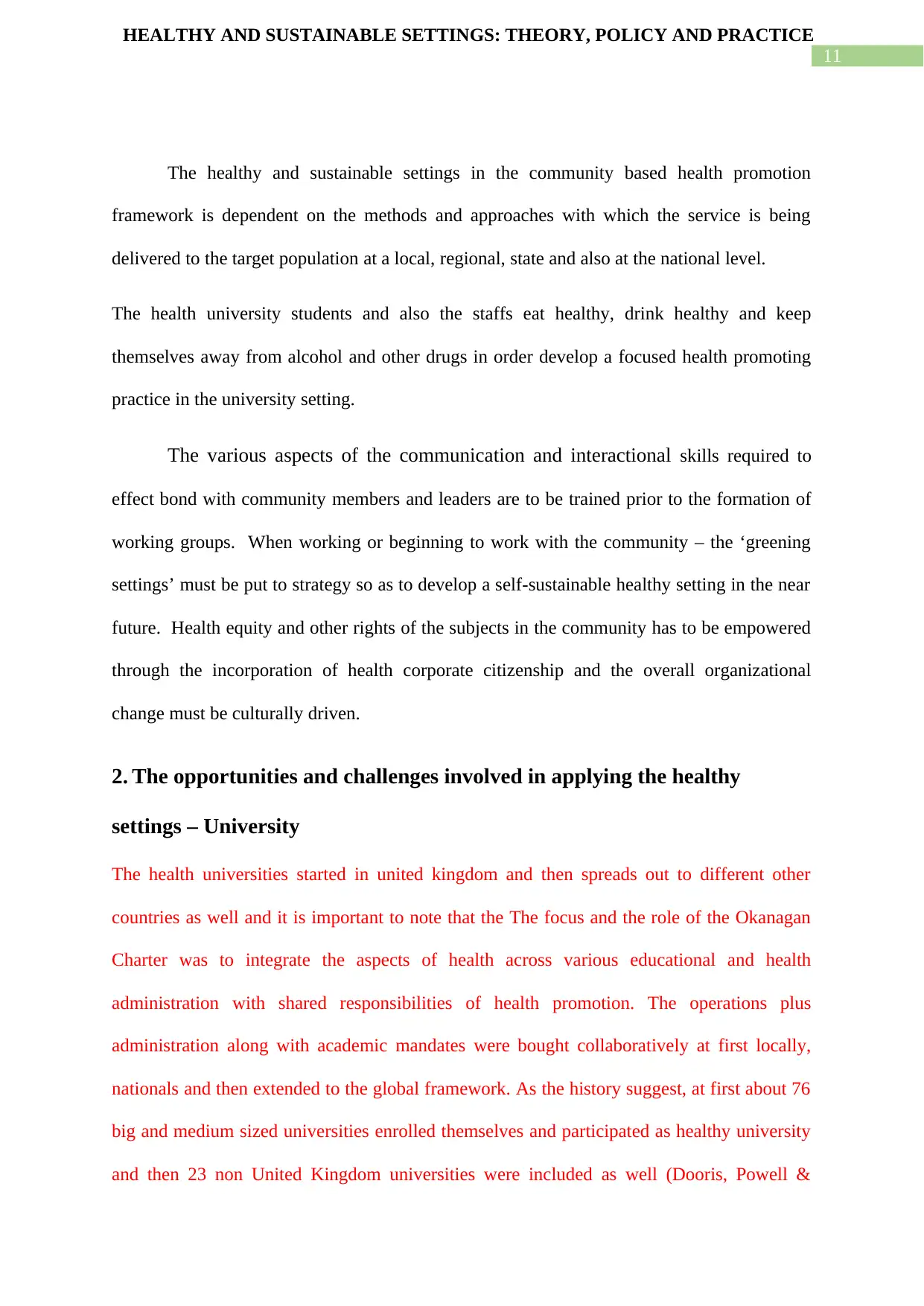
11
HEALTHY AND SUSTAINABLE SETTINGS: THEORY, POLICY AND PRACTICE
The healthy and sustainable settings in the community based health promotion
framework is dependent on the methods and approaches with which the service is being
delivered to the target population at a local, regional, state and also at the national level.
The health university students and also the staffs eat healthy, drink healthy and keep
themselves away from alcohol and other drugs in order develop a focused health promoting
practice in the university setting.
The various aspects of the communication and interactional skills required to
effect bond with community members and leaders are to be trained prior to the formation of
working groups. When working or beginning to work with the community – the ‘greening
settings’ must be put to strategy so as to develop a self-sustainable healthy setting in the near
future. Health equity and other rights of the subjects in the community has to be empowered
through the incorporation of health corporate citizenship and the overall organizational
change must be culturally driven.
2. The opportunities and challenges involved in applying the healthy
settings – University
The health universities started in united kingdom and then spreads out to different other
countries as well and it is important to note that the The focus and the role of the Okanagan
Charter was to integrate the aspects of health across various educational and health
administration with shared responsibilities of health promotion. The operations plus
administration along with academic mandates were bought collaboratively at first locally,
nationals and then extended to the global framework. As the history suggest, at first about 76
big and medium sized universities enrolled themselves and participated as healthy university
and then 23 non United Kingdom universities were included as well (Dooris, Powell &
HEALTHY AND SUSTAINABLE SETTINGS: THEORY, POLICY AND PRACTICE
The healthy and sustainable settings in the community based health promotion
framework is dependent on the methods and approaches with which the service is being
delivered to the target population at a local, regional, state and also at the national level.
The health university students and also the staffs eat healthy, drink healthy and keep
themselves away from alcohol and other drugs in order develop a focused health promoting
practice in the university setting.
The various aspects of the communication and interactional skills required to
effect bond with community members and leaders are to be trained prior to the formation of
working groups. When working or beginning to work with the community – the ‘greening
settings’ must be put to strategy so as to develop a self-sustainable healthy setting in the near
future. Health equity and other rights of the subjects in the community has to be empowered
through the incorporation of health corporate citizenship and the overall organizational
change must be culturally driven.
2. The opportunities and challenges involved in applying the healthy
settings – University
The health universities started in united kingdom and then spreads out to different other
countries as well and it is important to note that the The focus and the role of the Okanagan
Charter was to integrate the aspects of health across various educational and health
administration with shared responsibilities of health promotion. The operations plus
administration along with academic mandates were bought collaboratively at first locally,
nationals and then extended to the global framework. As the history suggest, at first about 76
big and medium sized universities enrolled themselves and participated as healthy university
and then 23 non United Kingdom universities were included as well (Dooris, Powell &
⊘ This is a preview!⊘
Do you want full access?
Subscribe today to unlock all pages.

Trusted by 1+ million students worldwide
1 out of 21
Related Documents
Your All-in-One AI-Powered Toolkit for Academic Success.
+13062052269
info@desklib.com
Available 24*7 on WhatsApp / Email
![[object Object]](/_next/static/media/star-bottom.7253800d.svg)
Unlock your academic potential
Copyright © 2020–2025 A2Z Services. All Rights Reserved. Developed and managed by ZUCOL.





